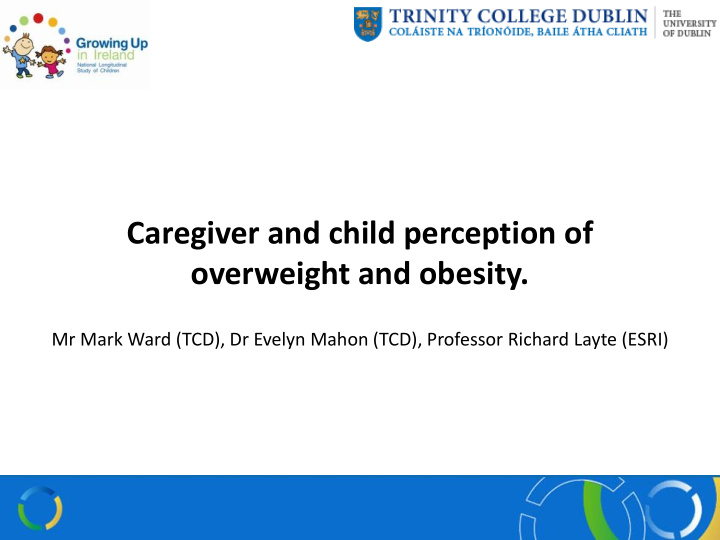



Caregiver and child perception of overweight and obesity. Mr Mark Ward (TCD), Dr Evelyn Mahon (TCD), Professor Richard Layte (ESRI)
Objectives (1) Are caregivers aware of their children’s weight status? (2) Are children aware of their own weight status? (3) Do children and their caregivers hold the same view of the child’s weight status? (4) Does the weight status of caregivers impact on their perception of their children’s weight status?
What does the literature say? Parent and child perceptions of their weight status often do not match their measured weight status. Parents are more likely to under estimate the weight status of boys than girls. Obese children shown to have lower self-esteem which can impact on the child’s overall self -concept. Children’s height and weight does not always correspond to an overweight self-identity. In order to address an issue it must first be recognised. Non-recognition may be a contributing factor to the ongoing increases in childhood overweight and obesity that we are observing.
Sample Nine-year-old cohort (N=8,568) 4,381 (51%) boys, 4,187 (49%) girls Measured height and weight for 8,089 (94%) of sample 98% of self-identified primary caregivers were women. Average age 39 years (Median=39, SD=5.7). 32% overweight, 20% obese, 46% healthy, 1% underweight
Measures Measured height and weight of both adults and children Scales and measuring stick Self-reported weight status of both adults and children
Introduction – Childhood obesity Excess body fat = energy intake > energy expenditure Causes Consequences Poor diet Health Sedentary behaviour Psychological Low physical activity Economic
Measuring weight status Body Mass Index – Kg/m² a weight to height ratio expressed as (weight divided by height squared)
Measuring weight status Body Mass Index – Kg/m² a weight to height ratio expressed as (weight divided by height squared) International Obesity Taskforce (IOTF)
IOTF cut-offs for overweight and obesity Healthy Overweight Obese Weight Boys age 9.5 19.5 – < 19.5Kg/m² > 23.4 Kg/m² years 23.4Kg/m² Girls age 9.5 19.5 – < 19.5Kg/m² > 23.5 Kg/m² years 23.5Kg/m²
Increase in children’s height ( cms) and weight (Kgs) in Ireland 130 125 Proportionate Increase 120 115 Height 110 Weight 105 100 1948 1970 2007 Year
Prevalence of childhood overweight and obesity in Ireland
Caregivers Self-Reported vs. Measured BMI
Caregivers Self-Reported vs. Measured BMI
Caregivers Perception of child weight status vs. actual
Caregivers perception of child weight status vs. actual
Study Child Perception of child weight status vs. actual
Study Child perception of weight status vs. actual
Accuracy of estimates Poor agreement between the parents’ perception and the measured weight status of nine-year-old children [Kappa: 0.04, p < 0.001] Poor agreement between child’s self -identified weight status and measured [Kappa: 0.09, p < 0.001] Good agreement between the estimates of caregivers and children [Kappa: 0.23, p < 0.001] 73% dyads correctly estimated the child’s weight status, 11% both under-estimated, 0.4% over-estimated 5% differed in their estimates.
Perceiving children to be overweight - CG measured BMI
Conclusions Rates of obesity have increased steadily – the biology of children has not changed. Both caregivers and children poor judges of children weight status – means problem not identified -- no corrective measures taken. CGs better at correctly estimating girls weight status, little difference in the obese category. Boys better estimating their own weight than girls particularly the obese group. Obese CGs significantly less likely to perceive girls to be overweight.
Final thoughts There is a need for improved recognition of obesity among parents. Danger of stigmatising children. Brief intervention by G.P’s / public health nurse?
References Cole, T., Bellizzi, M., Flegal, K., et al. (2000). Establishing a standard definition for child overweight and obesity worldwide: international survey. British Medical Journal , 320(7244):1240-3. Department of Health (1952). National nutrition survey, part 7, clinical survey . Dublin: Publication Office. Irish Universities Nutrition Alliance (IUNA) (2005). The National Children’s Food Survey . (Available at: www.iuna.net). Layte, R., McCrory, C. (2011). Growing Up in Ireland – Overweight and Obesity among 9- year-olds . Dublin: The Stationery Office. Perry, IJ., Whelton, H., Harrington, J., Cousins, B. (2009). The heights and weights of Irish children from the post-war era to the Celtic tiger. Journal of Epidemiology and Community Health ;63:262-4. Whelton ,H., Harington, J., Crowley, E., Kelleher, V., Cronin, M., Perry, IJ. (2007). Prevalence of Overweight and Obesity on the island of Ireland: Results from the North South Survey of Children's Height, Weight and Body Mass Index. BMC Public Health ; 7(187):1-9. Williams, J., Greene, S., Doyle, E., et al. (2009). Growing Up in Ireland – The lives of 9- year-olds . Dublin: The Stationery Office.
Acknowledgements The children and parents who participated in the study. PhD funded by the OMCYA National Children's Strategy Research Scholarship Programme. Dr Sinead Hanafin & Anne-Marie Brooks. School of Social Work and Social Policy TCD.
Recommend
More recommend